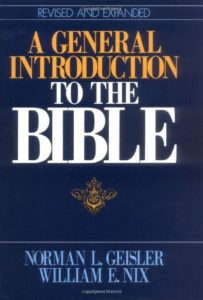
Norman L. Geisler and William E. Nix
Recommendation: 4/5
Description of authors: Norman Geisler, is currently the president of Southern Evangelical Seminary in Charlotte, NC. He is a well known apologist and writer. William Nix is an editorial and educational consultant based in Dallas, Texas.
Comments: This book answers the basic questions: What is the Bible? Where did it come from? and How has it come down to us? It is divided into four parts. The first part deals with inspiration – both the Biblical claim of inspiration as well as a review of the various views of inspiration. The second part examines the issues of canonicity. In this part they discuss questions like: Why does the Bible contain 66 books? Why do we not include the Apocrypha in our Bibles? Historically, how did the 66 books come to be accepted into the canon of Scripture? The third section reviews the transmission of the text. Here the authors discuss the history of manuscripts, textual criticism and the genuineness of the text of Scripture. The fourth and final section considers the issue of translation, including a brief history of the translation of the Bible in English. This is a superb introduction to these issues. Some of the highlights, from my perspective, are (1) The discussion on inspiration, which not only gives a good overview of the Biblical doctrine, but also gives a helpful analysis of the Liberal, Neo-orthodox, and Neo-evangelical views of Scripture; (2) Their analysis of the Apocrypha, including its history, Roman Catholic arguments for the inclusion of it, and the arguments for rejecting it (p. 264-75); (3) The history of the development of textual criticism (chapter 25); and (4) The history of the early English translations (chapter 30). The book also contains an appendix listing all the English translations from the 7th century down to 1985 (more than 1,100), a glossary, and an extensive bibliography. The three indices (subject, persons, and Scripture) render this volume a helpful reference tool. The only notable omissions that I lament are (1) a discussion of formal versus dynamic equivalency in translation (a rather glaring omission in my estimation) and (2) a discussion of the more recent translations (ESV, The Message, TNIV) – due, obviously, to the fact that this work is 20 years old.